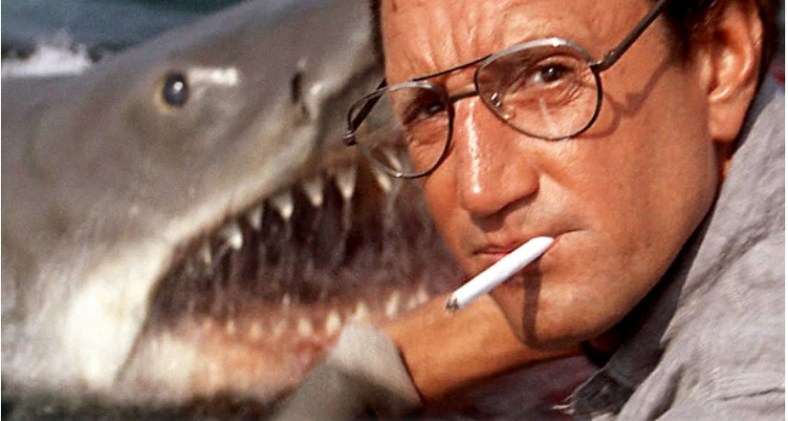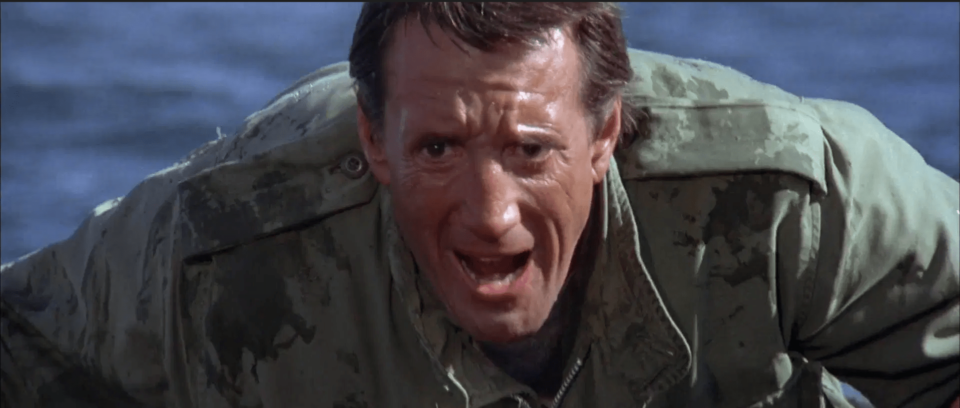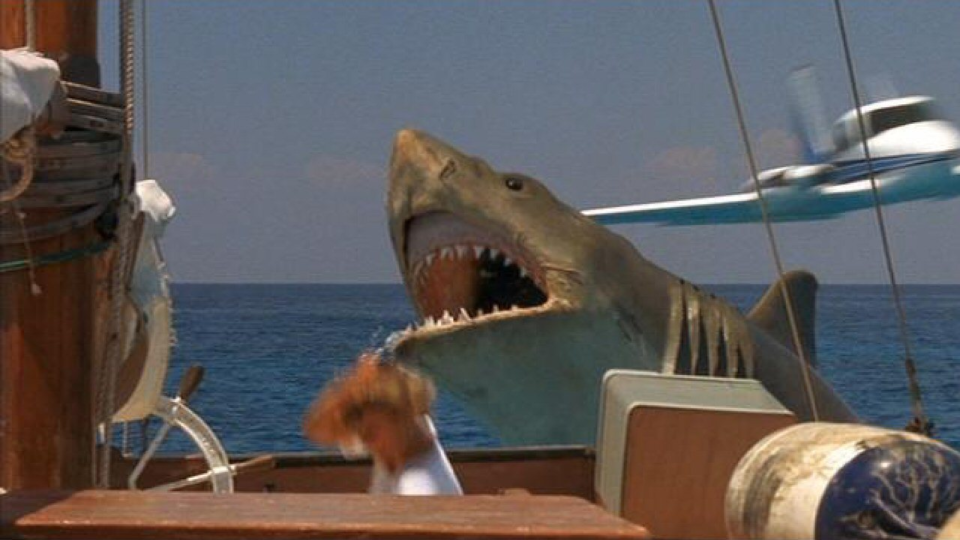From Fear to Folly: The Evolution of ‘Jaws’ and Its Sequels

As a kid growing up near a small beach town in southern New Jersey, I often wondered to myself when a Great White Shark would come and eat me. It’s probably why I stopped swimming for an extended period. Same with taking baths, if we’re being honest. As irrational as it was, the fear was genuine, and it was all because of Jaws.
The film series based on Peter Benchley’s 1974 novel is iconic as ever, even as Speilberg’s 1975 masterpiece nears its 50th anniversary on June 20, 2025. The film’s story continues to terrify viewers thanks to an iconic score, stellar acting and one of the best monster reveals in cinema history–even if it was never intended to play out that way.
Jaws is iconic and remains one of the most beloved horror films ever. After that, the franchise becomes murkier than the waters of Amity Island. A derivative yet fun enough sequel did enough to warrant additional entries. And that’s precisely where the wheels came off.
In honor of the film’s anniversary, now is the perfect time to dive into the genius and absurdity of the Jaws tetralogy.
Jaws (1975)

Jaws is why waves of people became horror fans, myself included. The film is near perfect despite production woes that would’ve ended most productions.
The cast of Roy Scheider, Robert Shaw, Richard Dreyfuss, Lorraine Gary, and others brought every character to life, offering glimpses into life on the tiny island and the struggles they all face. Watching Chief Brody evolve from someone afraid of the ocean into a hero is an arc few have been able to nail down as well in horror. Scheider was a force despite being about as much of an ordinary man as you could find.
On the production side, John Williams earned an Oscar for creating a score that ranks at the top or near the top of the best scores of all time. Steven Speilberg made his early mark by showing the world what he could do. Feats of brilliance included weathering a production hell that saw “Bruce” the shark malfunction regularly once it touched salt water. Similarly, the Orca, the fishing boat used by the trio to track down Jaws, also had trouble staying afloat.
But sometimes, the bad brings the great. Initially, Spielberg wanted to reveal the shark during the opening attack scene. But because they couldn’t get the shark to work correctly, production pivoted, delaying its reveal until later in the film. Instead of an immediate reveal and gore, we got one of horror’s best on-screen debuts.
The decision has been applauded by fans and critics alike. However, the horror of the scene goes deeper, with long-running allegations that the screams of the stunt actor in the opening attack scene, Susan Backlinie, were authentic. Stories claim her screams came from the pain of being jerked back and forth by underwater cables. The story continues despite the actress shooting down the claims years ago.
Jaws 2 (1978)

For the longest time as a kid, I swore that Jaws 2 was better than the original.
Turns out that wasn’t the case. I thank TBS Saturday afternoon cinema for always showing the two films back-to-back. Not only did you start my misconception, but you also helped end it.
Still, Jaws 2 isn’t that bad, especially for a sequel. Three years after the first attack, Chief Brody is struggling with what probably would be diagnosed as PTSD in modern times. Because of his mental state, most write off his assertions that another Great White is terrorizing the island. It doesn’t help that he opens fire into the ocean in an attempt to kill a shark that isn’t there. That’ll lose you public support almost every time.
Jaw 2 did a decent job of staying grounded for a shark film. That is if you disregard the scene where Jaws 2.0 chases down some jet skiers before ramming through the boat in a fiery blaze of glory. Later on, Eddie Marchand’s death proves that not only was Jaws 2.0 stronger than the original, but it also knew how to use its surroundings when going in for the kill.
Then, there’s the whole stalking teenagers thing. Some may call it natural predatory behavior, and I’d agree if we’re classifying the shark as a stalker because Bruce never lets up. Oh sure, the shark happened to hone in on the boat party with the Chief’s kids, right? Keep thinking that as we get sucked further into this franchise’s riptide.
Behind-the-scenes action adds to the lure of Jaws 2. While it didn’t have as many problems with the mechanical shark, the production faced headaches. Budget concerns and script changes plagued production, but most notable was the reluctance of star Roy Scheider. He likely would never have done the film if it weren’t for contractual obligations. How much more resistance Scheider might have put up had the proposed giant squid angle gotten the greenlight will remain a mystery.
Overall, Jaws 2 is enjoyed by some for its over-the-top follow-up to the original. Like a true sequel, it turns out the excitement, often with over-the-top deaths and scares, exemplified by a shark attacking a helicopter.
One person who reportedly isn’t a fan is Spielberg, calling the sequel “a cheap carny trick.”
But, at least we got one of the best taglines in film history: Just when you thought it was safe to go back in the water.
Jaws 3-D (1983)

Jaws 3-D might be the most offensive thing humans have done to the ocean since pollution.
1983 saw the franchise embrace cinema and tourist trends with the release of Jaws 3-D. Maybe the out-there premise focused on the adult Brody sons because Scheider had zero interest in returning.
“Mephistopheles couldn’t talk me into doing (it),” he said in 2002. No matter the reason, things get messy without Scheider around. With the first sequel feeling like a rehash of the blockbuster, Jaw 3-D went in a different direction, taking a relatively sharp right turn from its predecessors.
Chief Brody wasn’t the only missing fixture from the third iteration. Replacing Amity Island was SeaWorld in Orlando, Florida, where older son Mike as an engineer. When younger brother Sean shows up, so too does the killer shark.
That cheeky man-eater found a way to break into the park by tailing some staff through an open gate. From there, Jaws 3.0 does what Jaws does best, stalk and kill water skiers. From there, it wreaks havoc on the new undersea attraction, terrorizing park guests, dolphins, and some criminals in a raft.
But what truly makes Jaws 3-D the second scariest film about SeaWorld is its graphics. Even for the early ’80s, this is some of the worst 3-D you’ll come across. You’d think with a budget to attract Louis Gossett Jr. and a young Dennis Quaid, production could allocate some money for an even semi-passable shark. Instead, the graphics are beyond confusing, best summarized by Gossett Jr.’s death scene, featuring minimal scoring and a floating, motionless shark that’s more likely to make you burst into hysterical laughter than scream.
Seeing how comically bad the film turned out to be, maybe the original shark spoof idea would’ve been more effective.
Jaws: The Revenge (1987)

Jaws: The Revenge stands out for so many reasons.
Chief Brody dying off-screen years ago? You know Roy Scheider isn’t filming new material for this franchise.
A Christmas-time shark stalker plot? Boy howdy!
A shark that can set up murders in the frigid December Atlantic Ocean while also tapping into the Amity Island police scheduling system? Jaws was doing all that before Trello even came around.
That all happens in the first 20 minutes or so of the film.
From there, Ellen Brody is convinced to head to the Bahamas, where remaining Michael now lives with his family. After years of being stalked and attacked by sharks, he now works as a marine biologist where he hangs out with Mario Van Peebles in the waters of the Bahamas, where 40 or so types of sharks call home.
With Chief Brody not around to give off the weird sharkey senses, it’s Ellen’s turn to sound like a lunatic raving about a stalker shark. And she almost relents when she falls for the handsome charm of Michael Caine, who plays Hoagie, a name that was clearly inspired by someone ordering a foot-long sandwich in the Philadelphia area.
You’d think a Christmas-time, international, multi-species stalking plot would be what makes Jaws: The Revenge so bad it’s good. But that’s not the case.
Instead, the movie stands out for some genuinely questionable choices. The infamous “roar” is what stands out most to fans, with some highlighting its uncanny resemblance to a Tom & Jerry scene. Due to reshoots from fan reactions, the film also featured several changes from its original release. Depending on the release you catch, you could see dramatically different endings, including one where wood and a machine swallowed by a shark can somehow trigger an explosion
Then, there’s Michael Caine, who famously filmed the movie, skipping out on an Oscars evening where he won the Best Supporting Actor award for Hannah and Her Sisters. Adding to the story years later, Caine said the film was “One of the worst I’ve ever done” but has no regrets.
“I haven’t seen the film, but I’ve seen the house it bought my mother. It’s marvelous,” he said.
Jaws is Based On A True Story
Peter Benchley based his novel on a string of shark attacks along the Jersey Shore in 1916. Spanning a 12-day stretch beginning July 1, a Great White terrorized several beach towns, killing four and injuring one more. Known as the Jersey Shore Shark Attacks, the story captivated the nation and its fear of sharks. Jersey Shore Shark Attack is also going to be a Syfy film greenlit around 2030, starting The Situation from Jersey Shore. I have no proof that will happen, but just you wait.
Making matters more terrifying for the folks of New Jersey, the shark made its way into Matawan Creek, killing 11-year-old Lester Stilwell and injuring an adult who entered the water to save the boy. The shark non-fatally attacked another 14-year-old boy on its way out of the creek before swimming away. No other incidents were reported, leaving people to speculate if the shark was a Great White, Bull, or other shark breed.
Like the 1916 attacks, the Jaws franchise left a lasting impression on the public, making sharks out to be apex predator-killing machines. In response, shark hunting soared over the years, leading to overfishing in many parts of the world.
Both Benchley and Spielberg have stated they regret their portrayal of the animal and its impact on their population. In the years after the films, Benchley would become an advocate for ocean conservation until his passing in 2006. Today, activists like Benchley’s widow, Wendy, Ocean Ramsey, and others fight to combat the image of sharks while highlighting their importance in the ecosystem.
Jaws’ lasting impact on cinema and society remains as impactful as it was in the late 70s. Over-the-top shark thrillers are a subgenre that hasn’t let up much since Jaws‘ release. While some films came before Spielberg, Jaws accelerated the creation of shark horror. We still can’t go a year without at least some low-budget shark efforts hitting the screens. And while much of the credit is rightfully given to the original, the three follow-ups also deserve their chum.
Categorized:Editorials

